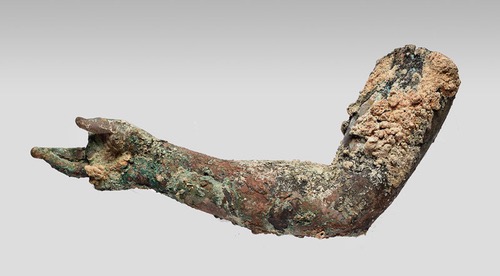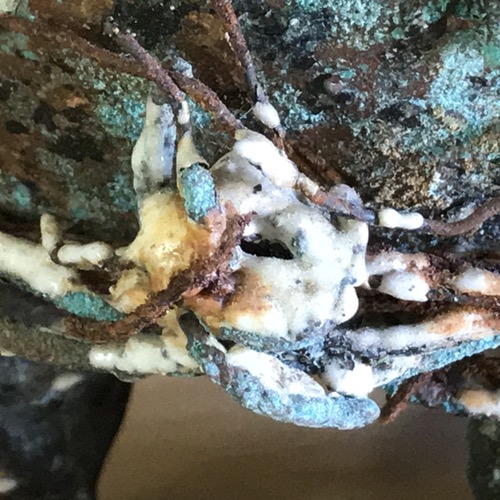Now I know how to achieve gorgeous textural surfaces on bronze. You must submerge the piece in the ocean for centuries!

When I saw the images of the bronze arm found during the archaeological expedition of the Antikythera Shipwreck, it reminded me of my research to create thick textural surfaces on bronze.

Antikythera Shipwreck Expedition, Detail of the Hand
I buried my bronze pieces with sodium mixtures and chemicals. I applied chemicals to my pieces and then set them on fire. I saturated burlap with chemicals, wrapped it around my pieces, then enclosed work in a plastic container. I applied low-fire ceramic glazes to bronze pieces and then fired them. And I did a combination.

This is a detail of a little bronze bowl that was bound with wire.
I applied Egyptian paste, low-fire glazes, and the lot was fired hot enough for
paste and glaze to mature, but not hot enough for the bronze and steel wire to become molten.
Egyptian paste is a self-glazing clay body. I have used it in a variety of ways, even as a self-glazing spackle when something needs to be filled.

Hardware cloth formed into a vessel and held in place with nails. Egyptian paste was applied and the lot was fired. The pink color is the result of the addition of red iron oxide added to the paste dry batch.
Post of Eroded Contours
My series that combined ceramic and bronze processes.
Antikythera Shipwreck Excavation
It appears that the Antikythera Shipwreck excavation photos I used in my post were taken by Brett Seymour/EUA/ARGO.
Found: A Giant Bronze Arm From the Antikythera Shipwreck
Antikythera shipwreck yields statue pieces and mystery bronze disc
Greece Ministry of Culture and Sports
